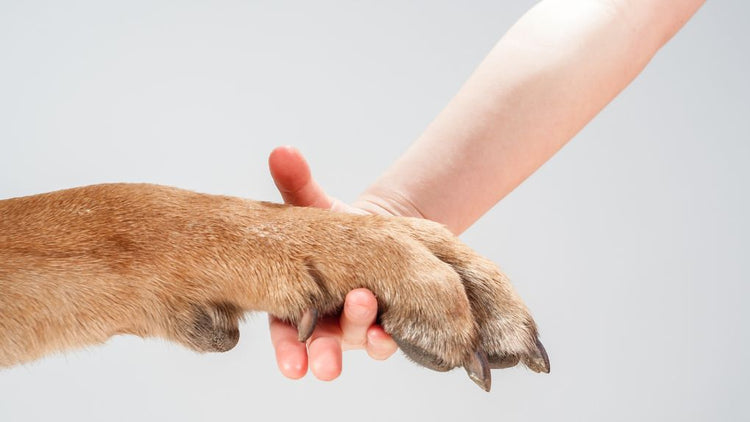Let’s talk desensitization and husbandry. Dogs don’t come to us being comfortable with handling, we can’t verbally tell them what we’re doing and why, so we need to go slow and build trust by listening to their body language and creating positive associations.
We’ll be using counter-conditioning, which means pairing something bad with something good, to slowly change your dog’s association with the “bad” thing.
The first step is to figure out what is triggering the fear response, for example with nail trimming, does seeing the trimmers make them back away? Or are they okay until you pick up their paw? Get to know your dog's body language and pay close attention to their fear cues. Common signs are:
- lip licking
- whale eye (seeing the white of their eyes as they look away)
- yawning
- tail tucking
- tucked/flattened ears
Next, you’ll want to take the smallest amount of that trigger possible, if they can have their paw picked up but after 2 seconds they start to squirm, start with 1 second. Pair this with food at the same time as exposure to the stimulus: we call this the Simultaneous step. Give them a treat as you pick up their paw and put the paw down as soon as or before they’re done eating the treat.

After a few repetitions of the Simultaneous step, they should no longer show fear when the trigger occurs, and you can move to a Delayed reward: pick up their paw then give them a treat, and put the paw down.
The last step is Separate: pick up then put down the paw, then give a treat.
If they continue to be calm after this step, you can increase the length of time or difficulty, or move on to the next trigger. For example once the paw pick-up is comfortable, you can move to bringing the trimmer up to their nail.
Note: while Simultaneous can sometimes work as a distraction, for desensitizing you want the dog to be aware of what’s happening. Let them sniff the object before you bring it to their body; if they stop eating the treat to look at what you’re doing, pause what you’re doing and allow them to look, if they go back to the treat you can keep going. We often see people using lick mats as more of a distraction than a tool for desensitizing and this can cause issues as you forge ahead through all the potential triggers until your dog is way over their fear threshold and notices what you’re doing and has a big reaction.
Working on longer behaviours
With something like nail trims, there are many little things happening your dog does not like. You may need to desensitize certain aspects of the job but not others.
We have a ladder of things to get your dog used to:
- The sound of the trimmers when the nail is clipped
- Being around the nail trimming instrument
- Touching the leg
- Holding the paw
- Bringing trimmers to the paw
- Separating the toes
- Touching the trimmers to the nail
- Clipping the nail
Your dog may already be okay with steps 1-4, so you want to start desensitizing to step 5. This process is fluid and you may also be able to go right from 3-5 no problem but get stuck on 6. Depending on your dog you may be able to find a workaround, or you may just need to feet simultaneously for a certain part of the task. That's ok! Remember the key is to listen to your dog's cues, don't push them too hard, and keep building that trust.
Tips from the pros
To desensitize to the trimming sound, practice trimming a dry piece of spaghetti a few feet away from your dog.
Introducing them to the nail trimmers separate of handling their feet is also a good idea. Start by putting them on the ground and letting your dog sniff them, place treats around the trimmers. Hold them in your hand and ask for a "shake" so your dog will purposefully touch their paw to the trimmers.
Bringing the trimmers to the paw and handling the feet may be two separate goals, think about desensitizing these in different sessions.
Remember, keep desensitizing sessions short!
Five minutes every day or two will make a world of difference. After 5 minutes you and your dog will both run out of patience, and you won't be making positive progress.


Thank you.
I will try these techniques toward getting our old rescue dog comfortable with nail trimming.